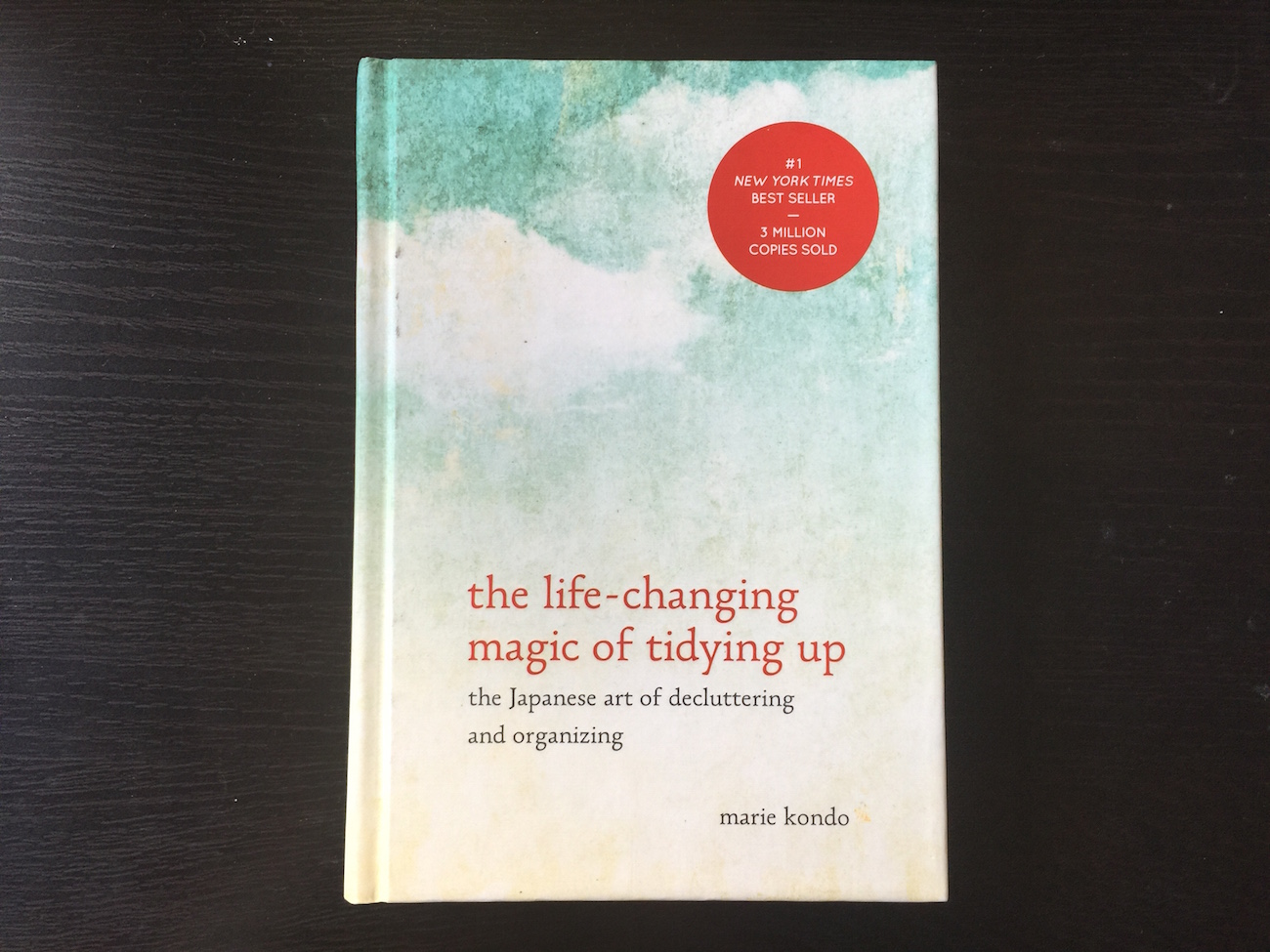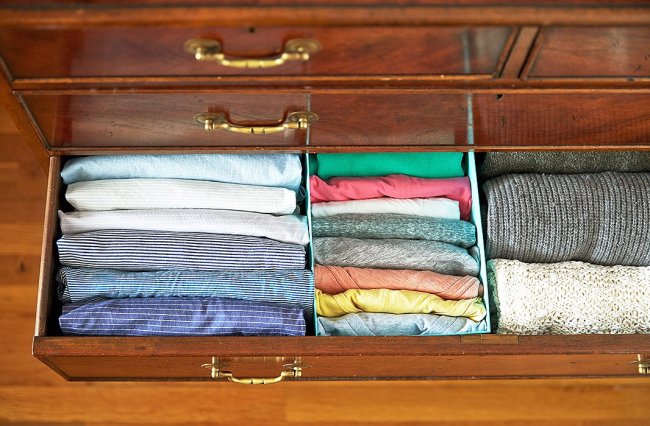[I don't typically discuss self-help books on Melting Asphalt, but bear with me while I try something new. Maybe this will be useful to you. At the very least, I'll benefit from rehashing my takeaways from this book.]
The Life-Changing Magic of Tidying Up: The Japanese Art of Decluttering and Organizing by Marie Kondo.
Published in 2014. 206 pages. Amazon link.
Recommendation: If you're into minimalism and need a little motivation, along with quirky advice on how to achieve it, then you'll probably enjoy this book. Otherwise you won't be missing out on much; you can get all the main ideas from write-ups like LifeHacker's, The Atlantic's, or this one.

HT: Nick Barr.
Overview
This is a self-help book. Marie Kondo promises to help you get your house in order. Her overall philosophy is minimalism — pretty straightforward. Many of her specific suggestions, on the other hand, are ceremonial or ritualistic, almost spiritual at times (apparently inspired by her experiences at Shinto temples). I found these suggestions charming and helpful, for the most part, but YMMV.
The main message Kondo preaches is that of cultivating a more deliberate relationship with your possessions. For everything you own, you should be asking yourself, "Does this serve me well? Does it bring me joy?" And if the answer is no, you have to throw it out.
This has two effects. First, it reduces clutter, bringing many benefits (see below). But second — and perhaps more important — it leaves you surrounded by things you actually love. For me, this has been the biggest and most surprising benefit. After throwing away all my low-quality cruft, I'm left only with my favorite versions of each item: pens I enjoy writing with, t-shirts that fit perfectly, knives with sharp blades and excellent handfeel, etc. And as a result, I've become much more attentive to my things and the joy of using them.
Why minimalism?
Before getting to the "KonMari method," I want to take a moment to reflect on the virtues of minimalism.
This is probably obvious to everyone: who wants a bunch of junk in their lives? It's always been obvious to me, at least intellectually — and yet my natural instinct is to save anything that "might be useful later." That old iPhone? Perhaps I'll find a use for it someday. That extra umbrella? It's a backup in case I lose my good one.
I suspect this is all just rationalized loss aversion. But the net result is that I end up with a bunch of junk.
Here's the problem (for me, at least): When deciding whether to keep something, the potential benefit — i.e., getting to use the item again when it's needed — is big and easy to visualize, while the costs of keeping the item are small and almost invisible. They're like little taxes and "handling fees" — any one of which is negligible, except that they add up to a sizable drag.
It can be helpful, then, to take stock of these costs. Each additional item:
- Contributes to a cluttered living space. And clutter gets in the way of both daily life and cleaning activities. If your couch is being used as temporary storage for books and papers, you can't sit on it or vacuum it.
- Makes it harder to find things. This is true even if everything is tucked away in its proper place, simply because it takes longer to search through all your items.
- Makes it harder to put things away. When your drawers and cabinets are cramped, it takes more effort to put things back in their proper place.
- Makes moving a bigger pain in the ass. Yeah.
- Creates psychological overhead. Each of your possessions is something you have to remember (because if you forget about it, you're losing most of the EV from keeping it in the first place).
But perhaps the biggest problem with keeping things, especially items of low value, is that they can prevent you from finding and using the things you truly love. When I cleaned out my sock drawer, for example, I found a number of awesome socks that had been languishing in the back of the drawer, buried and forgotten, while I continued to pick out older, shabbier socks from the front of the drawer.
Set against all these costs is, again, the benefit of getting to use the item in the future. But this benefit, while easy to imagine, is smaller than you might think. First there's the fact that your future use is only a possibility, and (if you're like me) you're probably exaggerating this possibility. Second, even if you do end up wanting to use the item in the future (after throwing it out), there are probably serviceable substitutes, or you can just get by without it. And if you truly need to use the item in the future, in most cases you can just go out and buy a new one.
So say it's an item that originally cost $50. If you throw it away, it might feel like you're losing $50 worth of value. But in expectation you're actually throwing away much less than $50. The real value is something like this:
(Chance you'll want to use it again) * (Value of item - Value of nearest substitute) + (Chance you'll need to use it again and be forced to buy a new one) * $50
Which, depending on the item, probably gives you something in the $1 to $10 range. And this, again, has to be weighed against all the costs.
The KonMari method
Broadly speaking, the KonMari method involves three steps:
- Purge: discard everything you don't need.
- Organize: put things in their proper places.
- Steady-state: live in your tidy new space.
Most of the book focuses on Step 1, but I'll discuss each briefly in turn.
Step 1: The purge
First, you'll want to purge in one fell swoop, a big one-shot discarding spree. You might space it out over the course of a few weekends, but as Kondo says, the purge should be a "once-in-a-lifetime event."
Why all at once? The goal is to create a profound, dramatic, emotional change. You're not just tidying and organizing. You're resetting your whole relationship with your possessions and your living space. You're trying to change your entire way of thinking and living. It's much harder to do that incrementally.
In practical terms, Kondo suggests going through your items category-by-category (rather than room-by-room). For example, you might do clothes, then books, then papers, then kitchen items, then miscellany, and finally things with sentimental value (photos, letters, etc.). You can also break things down within categories, e.g., shirts, pants, socks, underwear, accessories, shoes. But you'll want to do each category or subcategory on its own, comprehensively — especially if the items are spread out throughout the house. Gather them all together so you can take stock of everything at once.
And again, for each item, you should be asking yourself, "Does this bring me joy?" If the answer is yes, keep it. If the answer is no, discard it. (And given our bias toward hoarding, "maybe," of course, means "no.")
Step 2: Organize
The book offers a lot of specific tips for organizing your items, e.g., how to fold clothes. Some of these tips are useful, but they're not really worth rehashing here.
I did, however, take away two more general principles:
- Items of a given type should be kept in one and only one place.
- Don't stack things vertically if you can help it (e.g., books, papers, clothes). This makes it much harder to pull things out and put them back in the stack. Instead try to organize things horizontally whenever possible.
Here, for example, is how you might arrange your clothes horizontally in a dresser:

(Photo courtesy One Kings Lane.)
Step 3: Steady-state
Again, Kondo doesn't spend too much time discussing this part of her program, but she does offer a few tips. Here are the ones I remember:
- Always put things back in their proper place after you use them. (Duh?)
- When you bring new things into your house, don't leave them in limbo. Take them out of their packaging, remove tags and stickers, and put them away in the proper place. Make them first-class citizens of your home from the very beginning.
Tidying as ritual
As mentioned previously, the book is suffused with a Shintoist mentality. We're supposed to treat our homes and possessions with the same reverence we'd show at a temple or shrine. According to this attitude, our possessions aren't just lifeless things to be kept or discarded or taken for granted. They're active participants in our lives, partners who "want" to help us. And as such, they demand the same kind of ritual care that we accord our friends and loved ones.
All of this sounds decidedly strange to my Western ear. And yet I found most of the suggestions stemming from this mindset to be quite helpful. For example:
- During the purge, Kondo recommends touching each item — holding it in your hands — before deciding if it brings you joy. This makes sense to me: when you touch something, a more visceral part of your brain comes online and gets to weigh in on how it feels about an item.
- Before you throw each item away, especially if it's something you were attached to, Kondo suggests thanking it for its service. Go ahead, say it out loud: "Thank you for your service." Even if you never really used the item, you probably learned something from it, e.g., what qualities you appreciate in that type of object. Sure it's silly to talk to your possessions, but I actually found that it helped me make peace with throwing things away.
- If you're having trouble deciding how to store something, try personifying it and asking what it wants. For example, consider that pairs of socks might not want to be stretched into a ball (because it puts too much strain on the fabric), or that t-shirts don't like being stacked vertically (because the ones at the bottom get crushed). Similarly, luggage might be happiest if it's used to store other luggage inside it, like nested Russian dolls. You can also try asking your house where it would like things to be stored. Again, this is silly — except that it can provide a nice shift in perspective in case you get stuck. Inverted agency FTW.
- When you come home after a long day and put away your things (jacket, bags, etc.), you're supposed to thank them for working so hard on your behalf. Similarly, Kondo suggests greeting your home when you arrive: "Hi home, I'm glad to be here!" Near as I can tell, these rituals help maintain a deliberate, thoughtful attitude toward your possessions and living space, and keep you from taking them for granted or treating them with disrespect. (That said, I can't actually bring myself to greet my home. It just feels too weird.)
Random hacks
I'll leave you with two random tidying hacks that I particularly enjoyed:
- Decorate the back of your closet with things that make you happy. It's your personal space, no one else will ever see it, so why not give it a little emotional resonance. I'm imagining something like a high-school locker, with a poster of your favorite boy-band hanging on the back wall.
- Logos, brand names, and visible text on products and packaging constitute a form of visual clutter and should be eliminated whenever possible. For example, you might want to move things from their original packaging into a generic container, or cover up a brand name with a piece of tape.
_____
For more book reports, check out my reading page.
 Melting Asphalt
Melting Asphalt
